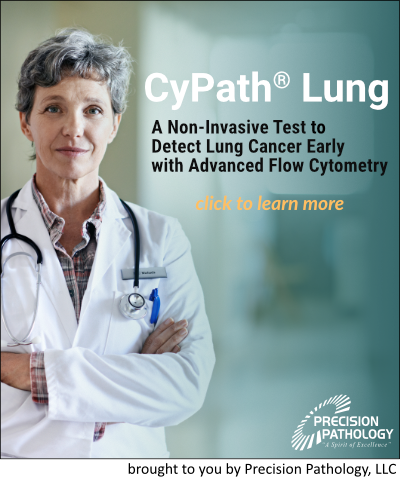Respiratory Research, January 21, 2023
Authors
Lemieux, M.E., Reveles, X.T., Rebeles, J. et al.
Abstract
Background
Low-dose spiral computed tomography (LDCT) may not lead to a clear treatment path when small to intermediate-sized lung nodules are identified. We have combined flow cytometry and machine learning to develop a sputum-based test (CyPath Lung) that can assist physicians in decision-making in such cases.
Methods
Single cell suspensions prepared from induced sputum samples collected over three consecutive days were labeled with a viability dye to exclude dead cells, antibodies to distinguish cell types, and a porphyrin to label cancer-associated cells. The labeled cell suspension was run on a flow cytometer and the data collected. An analysis pipeline combining automated flow cytometry data processing with machine learning was developed to distinguish cancer from non-cancer samples from 150 patients at high risk of whom 28 had lung cancer. Flow data and patient features were evaluated to identify predictors of lung cancer. Random training and test sets were chosen to evaluate predictive variables iteratively until a robust model was identified. The final model was tested on a second, independent group of 32 samples, including six samples from patients diagnosed with lung cancer.
Results
Automated analysis combined with machine learning resulted in a predictive model that achieved an area under the ROC curve (AUC) of 0.89 (95% CI 0.83–0.89). The sensitivity and specificity were 82% and 88%, respectively, and the negative and positive predictive values 96% and 61%, respectively. Importantly, the test was 92% sensitive and 87% specific in cases when nodules were < 20 mm (AUC of 0.94; 95% CI 0.89–0.99). Testing of the model on an independent second set of samples showed an AUC of 0.85 (95% CI 0.71–0.98) with an 83% sensitivity, 77% specificity, 95% negative predictive value and 45% positive predictive value. The model is robust to differences in sample processing and disease state.
Conclusion
CyPath Lung correctly classifies samples as cancer or non-cancer with high accuracy, including from participants at different disease stages and with nodules < 20 mm in diameter. This test is intended for use after lung cancer screening to improve early-stage lung cancer diagnosis.
Trial registration ClinicalTrials.gov ID: NCT03457415; March 7, 2018

